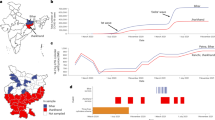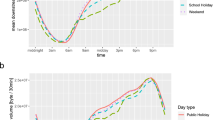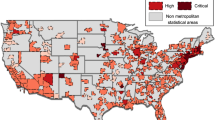Abstract
Energy insecurity is a growing public health threat among low-income populations in the United States. Prior research has shown that energy insecurity is associated with adverse health effects and can lead people to engage in risky coping strategies. Here we evaluate rates of energy insecurity, which factors contribute to it, and how the early months of the COVID-19 pandemic exacerbated the problem. We show that energy insecurity is highly prevalent among households at or below 200% of the federal poverty line. We further show that Black and Hispanic households are more likely to experience energy insecurity and face utility disconnection, as are households with young children, individuals that require electronic medical devices and those in dwellings with inefficient or poor conditions. These conditions exist under normal circumstances, and the COVID-19 pandemic seems to have exacerbated the overall incidence of energy insecurity.
This is a preview of subscription content, access via your institution
Access options
Access Nature and 54 other Nature Portfolio journals
Get Nature+, our best-value online-access subscription
$32.99 / 30 days
cancel any time
Subscribe to this journal
Receive 12 digital issues and online access to articles
$119.00 per year
only $9.92 per issue
Buy this article
- Purchase on SpringerLink
- Instant access to full article PDF
Prices may be subject to local taxes which are calculated during checkout





Similar content being viewed by others
Data availability
Data and associated materials used in this study are available in the Harvard Dataverse repository53, which includes the original survey data and codebook, the STATA data-processing do-file and the STATA data analysis do-file. Replication sources can be found at https://dataverse.harvard.edu/dataset.xhtml?persistentId=doi:10.7910/DVN/OMJWNB.
References
Hernández, D. Understanding ‘energy insecurity’ and why it matters to health. Soc. Sci. Med. 167, 1–10 (2016).
Hernández, D., Aratani, Y. & Jiang, Y. (2014). Energy Insecurity among Families with Children (National Center for Children in Poverty, 2014).
Residential Energy Consumption Survey 2015) (US Energy Information Administration, 2015).
Thomson, H., Bouzarovski, S. & Snell, C. Rethinking the measurement of energy poverty in Europe: a critical analysis of indicators and data. Indoor Built Environ. 26, 879–901 (2017).
Thomson, H. & Snell, C. Quantifying the prevalence of fuel poverty across the European Union. Energy Policy 52, 563–572 (2013).
Bouzarovski, S. & Petrova, S. A global perspective on domestic energy deprivation: overcoming the energy poverty–fuel poverty binary. Energy Res. Soc. Sci. 10, 31–40 (2015).
Bouzarovski, S. Energy poverty in the European Union: landscapes of vulnerability. Wiley Interdiscip. Rev. Energy Environ. 3, 276–289 (2014).
Ürge-Vorsatz, D. & Herrero, S. T. Building synergies between climate change mitigation and energy poverty alleviation. Energy Policy 49, 83–90 (2012).
Bednar, D. J. & Reames, T. G. Recognition of and response to energy poverty in the United States. Nat. Energy 5, 432–439 (2020).
Meder, B., Le Lec, F. & Osman, M. Decision making in uncertain times: what can cognitive and decision sciences say about or learn from economic crises? Trends Cogn. Sci. 17, 257–260 (2013).
Levy, R. & Sledge, J. A Complex Portrait: An Examination of Small-Dollar Credit Consumers (Center for Financial Services Innovation, 2012).
Campbell, R. B. Home Fires Involving Heating Equipment (National Fire Protection Association, 2016).
Bhattacharya, J., DeLeire, T., Haider, S. & Currie, J. Heat or eat? Cold-weather shocks and nutrition in poor American families. Am. J. Public Health 93, 1149–1154 (2003).
Bohr, J. & McCreery, A. C. Do energy burdens contribute to economic poverty in the United States? A panel analysis. Soc. Forces 99, 155–177 (2020).
Liddell, C. & Morris, C. Fuel poverty and human health: a review of recent evidence. Energy Policy 38, 2987–2997 (2010).
Mendell, M. J., Mirer, A. G., Cheung, K., Tong, M. & Douwes, J. Respiratory and allergic health effects of dampness, mold, and dampness-related agents: a review of the epidemiologic evidence. Environ. Health Perspect. 119, 748–756 (2011).
Shenassa, E. D., Daskalakis, C., Liebhaber, A., Braubach, M. & Brown, M. Dampness and mold in the home and depression: an examination of mold-related illness and perceived control of one’s home as possible depression pathways. Am. J. Public Health 97, 1893–1899 (2007).
Hernández, D. & Siegel, E. Energy insecurity and its ill health effects: a community perspective on the energy–health nexus in New York City. Energy Res. Soc. Sci. 47, 78–83 (2019).
Berko, J., Ingram, D. D., Saha, S. & Parker, J. D. Deaths Attributed to Heat, Cold, and Other Weather Events in the United States, 2006–2010 Report 76 (National Center for Health Statistics, Centers for Disease Control and Prevention, US Department of Health and Human Services, 2014).
Cook, J. T. et al. A brief indicator of household energy security: associations with food security, child health, and child development in US infants and toddlers. Pediatrics 122, e867–e875 (2008).
Frank, D. A. et al. Heat or eat: the Low Income Home Energy Assistance Program and nutritional and health risks among children less than 3 years of age. Pediatrics 118, e1293–e1302 (2006).
Nord, M. & Kantor, L. S. Seasonal variation in food insecurity is associated with heating and cooling costs among low-income elderly Americans. J. Nutr. 136, 2939–2944 (2006).
Snyder, L. P. & Baker, C. A. Affordable home energy and health: making the connections. AARP Public Policy Inst. 1, 5–36 (2010).
Garg, S. et al. Hospitalization rates and characteristics of patients hospitalized with laboratory-confirmed coronavirus disease 2019—COVID-NET, 14 States, March 1–30, 2020. Morbid. Mortal Wkly Rep. 69, 458–464 (2020).
Thebault, R., Ba Tran, A., Williams, V. The coronavirus is infecting and killing black Americans at an alarmingly high rate. Washington Post (7 April 2020).
Oppel Jr, R., Gebeloff, R. Lai, K., Wright, W., Smith, M. (2020). The Fullest Look Yet at the Racial inequity of Coronavirus. New York Times (5 July 2020)
Collins, C., Landivar, L. C., Ruppanner, L. & Scarborough, W. J. (2020). COVID‐19 and the Gender Gap in Work Hours. Gend. Work Organ. https://doi.org/10.1111/gwao.12506 (2020).
Fairlie, R. W., Couch, K. & Xu, H. The Impacts of COVID-19 on Minority Unemployment: First Evidence from April 2020 CPS Microdata IZA DP no. 13264 (IZA Institute of Labor Economics, 2020).
Montenovo, L. et al. Determinants of Disparities in COVID-19 Job Losses Working Paper 27132 (National Bureau of Economic Research, 2020).
Carley, S. & Konisky, D. M. The justice and equity implications of the clean energy transition. Nat. Energy 5, 569–577 (2020).
Jenkins, K. E., Stephens, J. C., Reames, T. G. & Hernández, D. Towards impactful energy justice research: transforming the power of academic engagement. Energy Res. Soc. Sci. 67, 101510 (2020).
Hernández, D., Jiang, Y., Carrión, D., Phillips, D. & Aratani, Y. Housing hardship and energy insecurity among native-born and immigrant low-income families with children in the United States. J. Child. Poverty 22, 77–92 (2016).
Mohr, T. M. Fuel poverty in the US: evidence using the 2009 residential energy consumption survey. Energy Econ. 74, 360–369 (2018).
Reames, T. G. Targeting energy justice: exploring spatial, racial/ethnic and socioeconomic disparities in urban residential heating energy efficiency. Energy Policy 97, 549–558 (2016).
Lyubich, E. The Race Gap in Residential Energy Expenditures Energy Institute WP 306 (Energy Institute at Haas, 2020).
Jessel, S., Sawyer, S. & Hernández, D. Energy, poverty, and health in climate change: a comprehensive review of an emerging literature. Front. Public Health 7, 357 (2019).
Graff, M. & Carley, S. COVID-19 assistance needs to target energy insecurity. Nat. Energy 5, 352–354 (2020).
Gross Domestic Product, Fourth Quarter and Year 2019 (Advance Estimate) (Bureau of Economic Analysis, 2020).
Min, J., Hausfather, Z. & Lin, Q. F. A high‐resolution statistical model of residential energy end use characteristics for the United States. J. Ind. Ecol. 14, 791–807 (2010).
Dubois, U. From targeting to implementation: the role of identification of fuel poor households. Energy Policy 49, 107–115 (2012).
Santamouris, M. et al. On the relation between the energy and social characteristics of the residential sector. Energy Build. 39, 893–905 (2007).
Pilkauskas, N. V., Currie, J. M. & Garfinkel, I. The great recession, public transfers, and material hardship. Soc. Serv. Rev. 86, 401–427 (2012).
Huang, J., Birkenmaier, J. & Kim, Y. Job loss and unmet health care needs in the economic recession: different associations by family income. Am. J. Public Health 104, e178–e183 (2014).
Flaherty, M., Carley, S. & Konisky, D. M. Electric utility disconnection policy and vulnerable populations. Electr. J. 33, 106859 (2020).
Lewis, J., Hernández, D. & Geronimus, A. Energy efficiency as energy justice: addressing racial inequities through investments in people and places. Energ. Effic. 13, 419–423 (2020).
Seefeldt, K. S. Constant consumption smoothing, limited investments, and few repayments: the role of debt in the financial lives of economically vulnerable families. Soc. Serv. Rev. 89, 263–300 (2015).
Vavreck, L. & Rivers, D. The 2006 cooperative congressional election study. J. Elect. Public Opin. Parties 18, 355–366 (2008).
Ansolabehere, S. & Rivers, D. Cooperative survey research. Annu. Rev. Political Sci. 16, 307–329 (2013).
Ansolabehere, S. & Schaffner, B. F. Does survey mode still matter? Findings from a 2010 multi-mode comparison. Political Anal. 22, 285–303 (2014).
Ross, L., Drehobl, A. & Stickles, B. The High Cost of Energy in Rural America: Household Energy Burdens and Opportunities for Energy Efficiency (American Council for an Energy Efficient Economy, 2018).
She, P. & Livermore, G. A. Material hardship, poverty, and disability among working‐age adults. Soc. Sci. Q. 88, 970–989 (2007).
Karpman, M., Gonzalez, D., Zuckerman, S. & Adams, G. What Explains the Widespread Material Hardship among Low-Income Families with Children? (Urban Institute, 2018).
Memmott, T., Konisky, D., Carley, S. & Graff, M. Replication Data for: Sociodemographic Disparities in Energy Insecurity among Low-Income Households Before and During the COVID-19 Pandemic (Harvard Dataverse, 2020); https://doi.org/10.7910/DVN/OMJWNB
Distribution of Total Population by Federal Poverty Level (Kaiser Family Foundation, 2018).
Acknowledgements
We thank D. Hernández for sharing her survey instrument on energy insecurity, which informed our own survey design. This research was supported through funding provided by the National Science Foundation, the Alfred P. Sloan Foundation, the Environmental Resilience Institute, funded by Indiana University’s Prepared for Environmental Change Grand Challenge initiative, and the Indiana University’s Office of the Vice President of Research.
Author information
Authors and Affiliations
Contributions
All the authors contributed to the conceptualization, research design, analysis and writing of this article.
Corresponding author
Ethics declarations
Competing interests
The authors declare no competing interests.
Additional information
Peer review information Nature Energy thanks Stefan Bouzarovski, Lee White and the other, anonymous, reviewer(s) for their contribution to the peer review of this work.
Publisher’s note Springer Nature remains neutral with regard to jurisdictional claims in published maps and institutional affiliations.
Supplementary information
Supplementary Information
Supplementary Tables 1–12.
Rights and permissions
About this article
Cite this article
Memmott, T., Carley, S., Graff, M. et al. Sociodemographic disparities in energy insecurity among low-income households before and during the COVID-19 pandemic. Nat Energy 6, 186–193 (2021). https://doi.org/10.1038/s41560-020-00763-9
Received:
Accepted:
Published:
Issue date:
DOI: https://doi.org/10.1038/s41560-020-00763-9
This article is cited by
-
The effect of residential solar on energy insecurity among low- to moderate-income households
Nature Energy (2025)
-
The comfort rebound from heat pumps and impact on household cooling behaviour and energy security
Nature Energy (2025)
-
Translating energy equity from a sociological concept to an electric power engineering perspective
Nature Reviews Electrical Engineering (2025)
-
Mapping the Gap: A Review of Residential Energy and Transportation Deficit Metrics
Current Sustainable/Renewable Energy Reports (2025)
-
Incidence, depth, and severity of energy poverty in Central and Eastern Europe in 2020: What factors make a household fall deeper into a predicament?
Energy, Ecology and Environment (2025)



